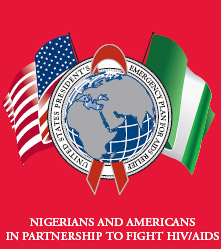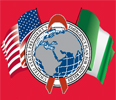| 2008 Country Profile: Nigeria PDF version PDF version

 |
|
2008 Country Profile: Nigeria
National HIV prevalence rate among adults (ages 15-49): 3.1 percent1
Adults and children (ages 0-49) living with HIV at the end of 2007: 2.6 million1
AIDS deaths (adults and children) in 2007: 170,0001
AIDS orphans at the end of 2007: 1,200,0001
Nigeria is one of PEPFAR’s 15 focus countries, which collectively represent approximately 50 percent of HIV infections worldwide. Under PEPFAR, Nigeria received more than $70.9 million in Fiscal Year (FY) 2004, more than $110.2 million in FY 2005, approximately $163.6 million in FY 2006, and 304.9 million in FY 2007 to support comprehensive HIV/AIDS prevention, treatment and care programs. PEPFAR is providing $447.6 million in FY 2008. | |
Recognizing the global HIV/AIDS pandemic as one of the greatest health challenges of our time, President George W. Bush announced the President’s Emergency Plan for AIDS Relief (PEPFAR) in 2003 — the largest international health initiative in history by one nation to address a single disease. The United States is changing the paradigm for development, rejecting the flawed “donor-recipient” mentality and replacing it with an ethic of true partnership. These partnerships are having a global impact and transforming the face of our world today.
Partnership to Fight HIV/AIDS
The Nigerian Government created the National AIDS Control and Prevention Program within the Federal Ministry of Health in 1987, a Presidential AIDS Commission comprised of ministers from all sectors in 1999 and the National Action Committee on AIDS based in the Office of the Presidency in 2000. The HIV/AIDS Emergency Action Plan developed in 2001, and revised in 2004, serves as the national action framework.
PEPFAR activities are carried out in close collaboration with Nigerian authorities, including the National Action Committee on AIDS, the Federal Ministry of Women’s Affairs, the Ministry of Defence and the Federal Ministry of Health. These activities include:
- Enlisting popular support and political will for HIV/AIDS prevention, treatment and care activities and policies;
- Developing the capacity of non-governmental organizations and government agencies, as well as national, regional, state and local organizations;
- Adopting new indigenous partners, particularly in strategically-selected, high-prevalence states;
- Integrating HIV counseling and testing and antiretroviral treatment into the National Tuberculosis Control Program;
- Establishing a regional training laboratory dedicated to providing training for tuberculosis laboratory technicians on HIV testing and treatment; and
- Establishing a system to stratify laboratories using standardized criteria and a quality-assured network of laboratories.
| PEPFAR Results in Nigeria |
| # of individuals receiving antiretroviral treatment as of March 31, 20081 |
|
162,500 |
| # of HIV-positive individuals who received care and support in FY2007 (including TB/HIV)1 |
|
244,600 |
| # of orphans and vulnerable children (OVCs) who were served by an OVC program in FY20071 |
|
37,400 |
| # of pregnant women receiving HIV counseling and testing services for PMTCT since the beginning of PEPFAR1,2 |
|
450,300 |
| # of HIV-positive pregnant women receiving antiretroviral prophylaxis for PMTCT since the beginning of PEPFAR1,3 |
|
27,000 |
| # of counseling and testing encounters (in settings other than PMTCT) in FY20071 |
|
966,100 |
| # of individuals reached with community outreach HIV/AIDS prevention programs that promote Abstinence and/or Being Faithful in FY2007 |
|
3,310,100 |
| # of individuals reached with community outreach HIV/AIDS prevention activities that promote Condoms and related prevention services in FY2007 |
|
534,800 |
| # of USG condoms shipped from Calendar Year 2004 to 2007 |
|
4,704,000 |
|
Note: Numbers may be adjusted as attribution criteria and reporting systems are refined.
Numbers above 100 are rounded to nearest 100.
1 Total results combine individuals reached through downstream and upstream support.
2 It is possible that some individuals were counseled and tested more than once.
3 It is possible that some pregnant women received antiretroviral prophylaxis more than once over the four-year period, e.g. HIV positive women who were pregnant more than once. |
 |
PEPFAR Achievements in Nigeria to Date |
|
HIV/AIDS in Nigeria
In Nigeria, the HIV prevalence rate among adults ages 15-49 is 3.1 percent. Nigeria has the third-largest number of people living with HIV. The HIV epidemic in Nigeria is complex and varies widely by region. In some states, the epidemic is more concentrated and driven by high-risk behaviors, while other states have more generalized epidemics that are sustained primarily by multiple sexual partnerships in the general population. Youth and young adults in Nigeria are particularly vulnerable to HIV, with young women at higher risk than young men. There are many risk factors that contribute to the spread of HIV, including prostitution, high-risk practices among itinerant workers, high prevalence of sexually transmitted infections, clandestine high-risk heterosexual and homosexual practices, international trafficking of women, and irregular blood screening.
Challenges to PEPFAR Implementation
Nigeria is emerging from a period of military rule that accounted for almost 28 of the 47 years since independence in 1960. Consequently, the policy environment is not fully democratized. Civil society was weak during the military era, and its role in advocacy and lobbying remains |
|
 |
| weak. The size of the population and the nation pose logistical and political challenges particularly due to the political determination of the Nigerian Government to achieve health care equity across geopolitical zones. The necessity to coordinate programs simultaneously at the federal, state and local levels introduces complexity into planning. The large private sector is largely unregulated and, more importantly, has no formal connection to the public health system where most HIV interventions are delivered. Training and human resource development is severely limited in all sectors and will hamper program implementation at all levels. Care and support is limited due to the fact that existing staff are overstretched and most have insufficient training in key technical areas to provide complete HIV services.
Critical PEPFAR Interventions for HIV/AIDS Prevention:
- Partnered with the government to initiate and roll-out early infant diagnosis HIV testing.
- Achieved successes through a youth-centered program addressing abstinence and faithfulness. Consolidated a successful “Zip-Up” abstinence program for youths and facilitated the creation of HIV/AIDS awareness clubs in both secondary and higher educational institutions.
- Established series of comprehensive prevention events at military bases, which targeted 2,500 troops and community members with messages on abstinence, faithfulness, and correct and consistent use of condoms, as well as HIV counseling and testing services.
- Facilitated capacity-building efforts resulting in the National Blood Transfusion Services taking a greater leadership role and coordination capacity in the implementation of the Nigeria National Blood Safety Plan.
Critical PEPFAR Interventions for HIV/AIDS Treatment:
- In FY 2007, supported 141 sites providing antiretroviral treatment including government, faith-based and military facilities.
- Assisted in the development of the National Antiretroviral Treatment Guidelines to ensure that harmonized quality care is provided to all people living with HIV/AIDS.
Critical PEPFAR Interventions for HIV/AIDS Care:
- Developed the National Palliative Care Guidelines to enhance quality and effectiveness of the National Palliative Care services. The comprehensive document models World Health Organization and U.S. Government policies, including a basic set of palliative care services delivered at the facility and community- and home-based level.
- Increased training opportunities for professional and volunteer home-based care providers. Mobilized and involved people living with and affected by HIV/AIDS in the delivery of home-based care services.
- Supported the Federal Ministry of Women’s Affairs to develop the National Plan of Action on orphans and vulnerable children (OVCs) that provides a direction for the national OVC program over the next five years.
1 UNAIDS, Report on the Global AIDS Epidemic, 2008. |
| |  |  |




 PDF version
PDF version